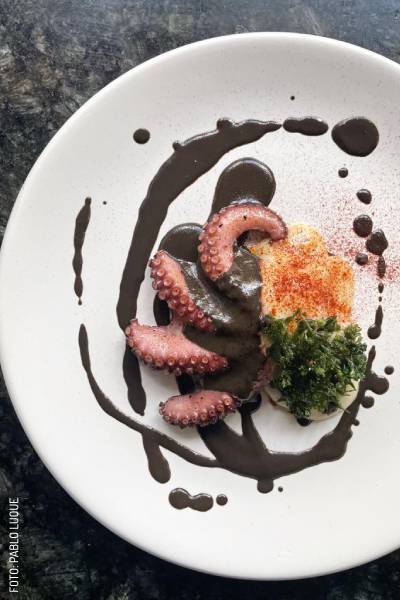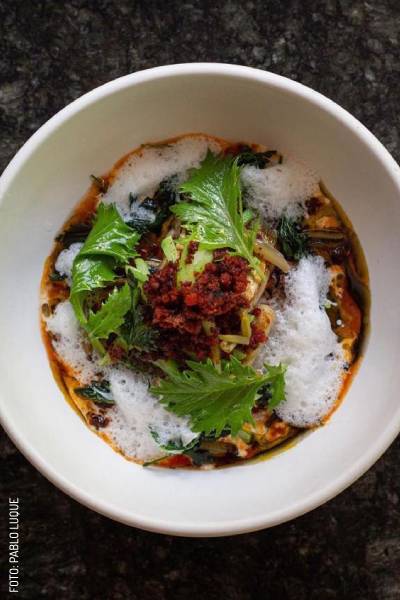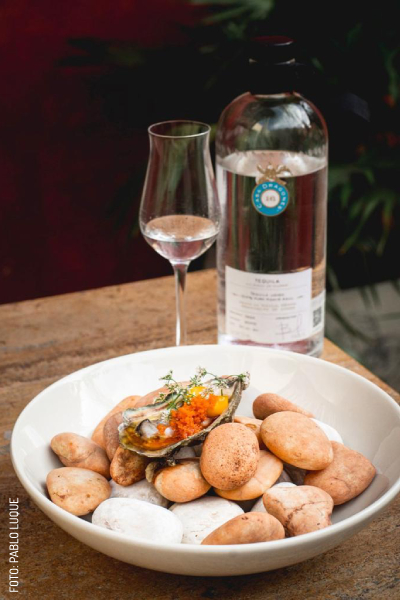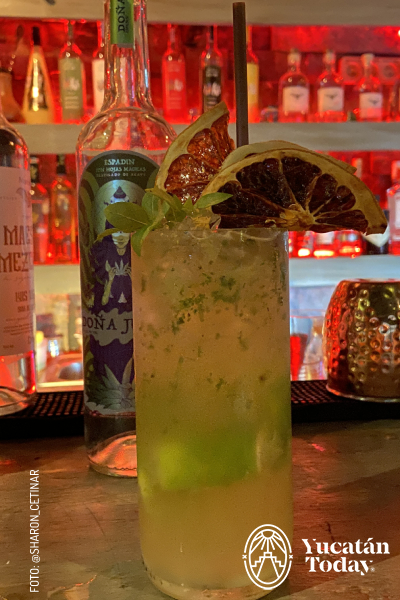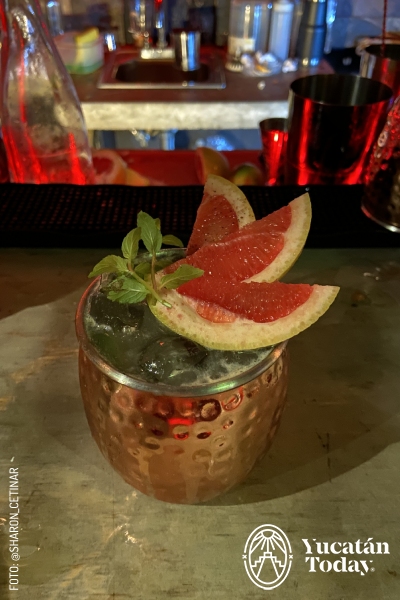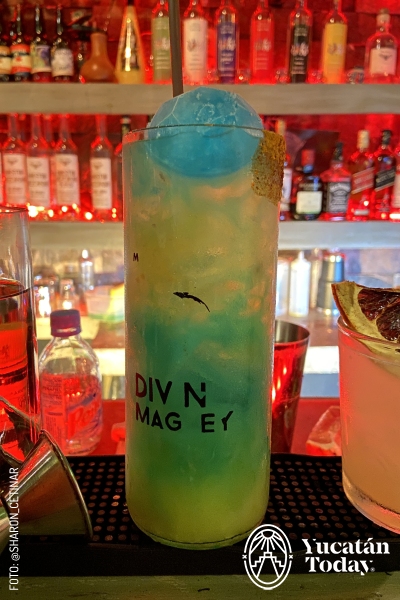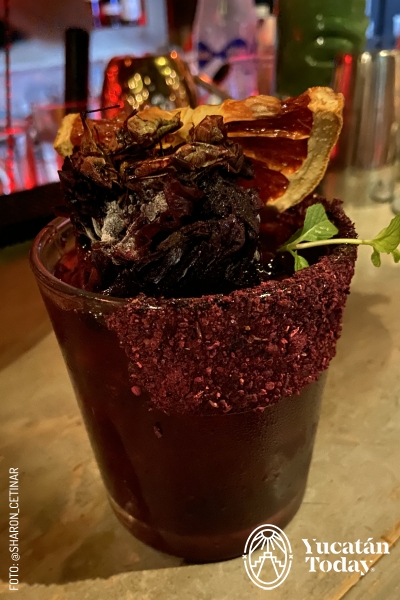Yucatán is having a foodie renaissance, where it already seems simply impossible to visit every restaurant or bar out there. The local culinary scene features very well renowned chefs, such as Elio Xicum, Luis Ronzón, or Christian Bravo, but how about those who are still up-and-coming, getting their name (and food) out there? Here are some local chefs under 30, listed with the places where you can try what they have to offer.
Allow us to present to you:
- Erick Bautista at NOL
- Fernanda Castillo at Mobula
- Gael Polanco at hotel NH Collection
- Pablo Luque at Izel
- Jorge Manzanilla at Murciégalo
- Romario Suárez at Crabster
Erick Bautista Chacón at NOL
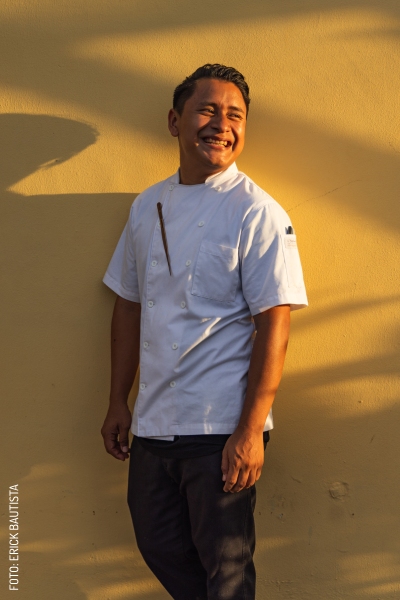
NOL is a very recently opened restaurant just across from Parque de Santa Lucía. In an area as densely populated with restaurants, you might wonder what could be special about NOL, and I’m happy to report I have your answer: Erick Bautista is. Having worked at the renowned Ixi’im (within the Chablé Yucatán hotel in Chocholá), and then getting his career at Huniik cut short by a certain health crisis a couple of years ago, Erick is no stranger to adversity; he had it so hard at one point, he struggled to (literally) build and open a coffee shop, and was ready to completely give up cooking and get a job at a wind farm.
It was his connection to renowned Yucatecan chef Elio Xicum that inspired Erick to enter the S. Pellegrino Young Chef Academy Competition, which he ended up winning for Latin America. The dish Erick created for the competition, which he named “Oaxaca, its land and its hands,” was based on a childhood memory of his aunt making him black bean tamales. He “dressed up” the tamal by incorporating nixtamalized (lime-cooked) tomatoes, pickled onions, corn, chili peppers, cacao beans, plumeria (frangipani) flowers, and piloncillo: the ingredients he had on hand, since he wasn’t able to afford shopping for ingredients. Because in his native Mixtepec food is always prepared in clay cookware, he came up with the idea to cook the clay plate along with the tamal; again, unable to afford clay, he and his wife, Arlette Poot, resorted to making it themselves: he dug the hole in their backyard (to source the dirt) and she modeled the clay pot the dish was cooked in.
“It was an accidental dish,” he says, “because I made it with what I had laying around, and without planning it, I came up with a vegan dish.”
Erick does not hold back on his admiration and gratitude to both chef Elio, who inspired, encouraged, and supported him in joining the competition, and Oaxacan chef Rodolfo Castellanos, who mentored him throughout the competition, and whom Erick describes as “an angel” along his way.
Having tried Erick’s dishes, I’d say we should all be grateful to them, for keeping a culinary talent such as his from going to renewable energies. Erick’s outstanding creations, including “Oaxaca, its land and its hands,” are now available for you to try at NOL. “Oaxaca” is part of the tasting menu, but the dishes available to order à la carte are also award-worthy; my personal must-have is the Crudo de Totoaba, a fish tartare served with a cucumber-chaya sauce, but having tried a few, I don’t think you can go wrong.
NOL
Calle 60 #473 x 53 y 55, Centro, Mérida
IG: nol_restaurante / erickbautistachacon
Fernanda Castillo at Mobula
You might find this hard to believe, but current Progreso boardwalk fixture Mobula opened its doors just over a year ago, in October 2022. Back then, the chef who would have run the restaurant’s kitchen had to bow out due to personal reasons; Fernanda Castillo, then sous-chef under him, was chosen to lead instead.
Fernanda was not by any means inexperienced. Born and raised in the village of Telchac, she had moved to Mérida to go to culinary school (much against her mother’s wishes) and got an early career start at small restaurants as a line cook. One of the things those experiences taught her was how she didn’t want her own kitchen to be run one day, as she had to deal with what we would now consider to be a very toxic work environment: verbal abuse and harassment with just a dash of sexism for good measure. Another Ixi’im alum, Fernanda says it was chef Luis Ronzón’s kitchen where she learned what it took to be not only a chef, but a leader. Describing him as her mentor, she talks about his eye for detail and the high-standard expectations he would set for everyone working under him, which she considers pivotal for her own personal and professional growth.
As she took over Mobula’s kitchen, it seems she made it her mission to turn her team into a family, and from the looks of it, she’s very much succeeded at it. Her initial uncertainty at leading such a diverse (and mostly male) team as a 28-year-old has disappeared as her infectious enthusiasm has inspired their own excitement and passion for sharing what they do. Fernanda proudly boasts how young Mobula’s cooks are (all of them in their early 20s) and how their creativity and hard work translates into every dish they make.
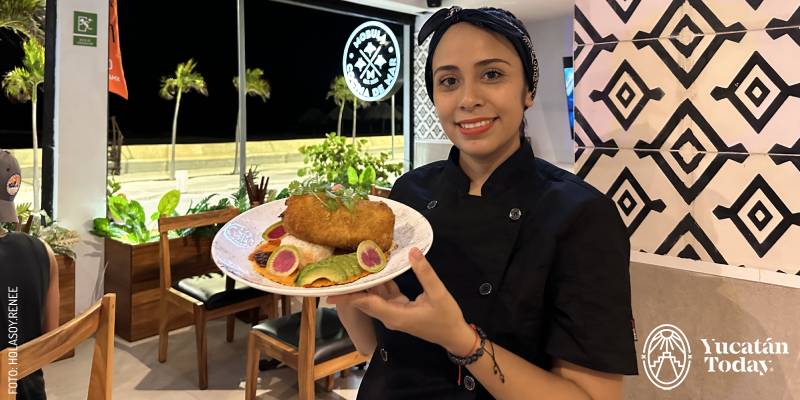
To get a taste of what Fernanda has brought to Mobula’s table, try the salmon toast if you’re there for breakfast, or the shrimp Chile Relleno (stuffed Poblano) served over a bell pepper sauce if you’re there for lunch or dinner. If you happen to be there when the restaurant isn’t too crowded, ask your server about Tablitas: Fernanda loves to create combinations based on diners’ cravings, and send them out on a sizzling hot cast iron griddle. Ours featured a Mojo de Ajo grilled octopus, coconut shrimp, and arrachera steak, plus side dishes—a great way to share and try a very satisfying variety of options.
Mobula
Malecón Tradicional x calle 74, Centro, Progreso
IG: mobulamx
Gael Polanco at NH Collection Hotel
There’s a secret hiding in plain sight at the NH Collection hotel in Paseo 60, and that’s chef Gael Polanco. At only 23 years old, Gael is the chef in charge of the hotel’s kitchen. Despite his young age, he’s had a world of experience, having worked in the industry since he was only 14. But before you call social services on his mom, keep in mind that she’s an old-school traditional baker, who supported her family by making Tres Leches and Queso de Bola cakes; this is what sparked Gael’s interest in cooking in the first place.
At age 17, though, Gael got a job at a hotel, where he worked under chef Carlos Olvera. As he puts it, his young, rebellious self was not very appreciative of chef Olvera’s high standards and apparently excessive demands at first, but Polanco now sees the discipline he acquired as pivotal to continue learning, growing, and improving at his passion. He’s grateful to Olvera for pushing him to be where he is now, and still considers him a mentor.
A Yucatán native, Gael is excited to be a part of the new wave of appreciation for Yucatecan cuisine that’s taking México by storm. He’s deeply appreciative of the richness of our local ingredients and preparations, but believes the overuse of staples like Achiote or bitter orange might lead to fatigue, when there’s an endless list of local flavors that have yet to be explored. “Chefs, especially young chefs, have to try to bring forth a new twist to Yucatecan cuisine: not reinvent it, but to experiment and discover, to create something new. We weren’t born into this world to do the same thing over and over again, but to find the hallmark that identifies us.”
Despite being a well-rounded chef, Gael has a soft spot for pastry arts; it was his reinterpretation of a mille-feuille pastry that won him the Sibarita Food Fest Young Talent contest. In his own words, this sweet creation reflects a fusion of Yucatecan, Asian and Yucatecan influences: it features a Hocabá orange peel gel, Italian meringue flambéed with local limes, ginger crème mousseline, and local oregano ice cream quenelle. Describing it, he says, “I think that, in a way, it’s the definition of me as a pastry chef: using regional products as headliners, and then amplifying them through culinary techniques we’ve learned from other cultures; as I like to say, that’s Yucatán: a mix of the cultures that have come before it.”
You can try chef Gael Polanco’s mille-feuille pastry at the NH Collection Hotel, as well as his own take on several Spanish classics featured on the hotel’s menu. For special occasions, you can also order off his own bakery project at IG: horno09
NH Collection Hotel
Paseo 60: Calle 60 x 35 y Av. Colón, Centro, Mérida
IG: gael.polanco
Pablo Luque at IZEL
Pablo Luque comes from the Mexican state of Veracruz, and while you don’t need to be familiar with his place of origin to appreciate his cuisine, it does help you get a better understanding of it. While Veracruz isn’t the largest state in México (it’s the 12th largest, out of 32), it’s one of the longest, stretching roughly 650 km (403.9 mi); about a third of México’s Gulf coast belongs to Veracruz, but so does the highest mountain in México (and the third in North America), el Pico de Orizaba. So we’re talking about a very geographically diverse state, with climates that go from very, very cold up in the mountains to a warm, humid coastline.
Talking to Pablo, his love for his home state comes across easily and enthusiastically. While his career began—as he proudly narrates—working at a hot dog cart in Veracruz, as a culinary student he joined renowned anthropologist Raquel Torres Cerdán’s traditional Mexican cuisine workshops. It wasn’t long before he became an assistant there, and got to participate in a myriad of hands-on explorations of México’s, and especially Veracruz’s culinary richness. He took his love and enthusiasm with him when he joined Lur, a project by chefs Mikel Alonso and Gerard Bellver in México City, and later El Cuarto Blanco, in Xalapa, under chef Luis Palmeros.
And then, as luck would have it, a friend of his here in Mérida offered to let him use his kitchen; that led to him developing a place of his own to open here. Eager to share a contemporary twist on Veracruz’s delicious traditional food, he wanted to use authentic ingredients; unfortunately (though, actually, fortunately), Yucatáns’ very particular weather made it impossible for even preserves to survive. That’s how Pablo got into fermentation, a process that extends perishables’ shelf life and opens a world of possibility for new creations.
You see, Pablo is a staunch believer in sustainability. Through fermentation, he says, he can do his part to minimize food waste and resource depletion, by using ingredients off-season without harming the environment or farmers’ livelihoods. He’s also involved in a project for sustainable fishing, which promotes better practices and supports local fishermen and, in turn, makes for better-quality seafood.
That’s pretty much the history behind Izel, Pablo’s own project, currently housed at the Palomas Hotel on Calle 64 x 49, just a block away from Mérida’s Culinary Corridor. Well-known for being the place for unique twists on the usual breakfast options, Izel is just about to start opening for lunch and dinner between January and February; some of the dishes you can look forward to include a shelled crab taco served with a creamy Seco Meco chile sauce, a Veracruz-sauce fish, or a Mole de Xico made with miso-style fermented cacao. If you can’t wait (or maybe even if you can), ask about chef Pablo Luque’s tasting menu (subject to availability and advance booking). Based on Veracruz’s varied ecosystems, the eight-course menu features a mix of ingredients, techniques, and temperatures, and changes by season. It’s a great way to get a taste of Veracruz, through Pablo’s outstanding perspective.
Izel
Calle 64 x 49 y 53, Centro, Mérida
IG: izel.rest / pabloluke
Jorge Luis Manzanilla at Murciégalo
Jorge Luis Manzanilla is a trained chef. After graduating with a food-and-beverage technical degree from the local CONALEP school (a vocational high school, similar to the United States’ CTE system), he went to culinary school at Universidad Latino, then interned at the NH Collection Hotel in Paseo 60. While he was there, though, he told chef Carlos Olvera that he was interested in the vacant position at the hotel bar. As he recalls it, that might have been on a Monday; by Thursday, he was the hotel’s newest bartender. That was the beginning of Jorge’s career as a mixologist.
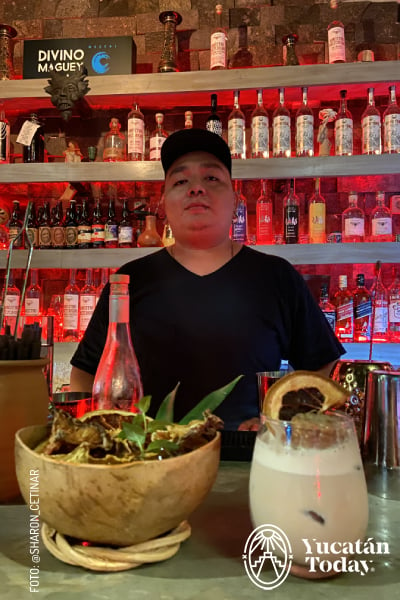
Manzanilla, as he likes to be called, isn’t just about mixing cocktails. He was born in Mérida, but his father’s family hails from Hocabá, a Yucatán municipality near the cenote haven of Homún. He grew up experiencing life in the village, and fondly remembers how his grandma would cook armadillo, ocellated turkey, or whatever else the family caught after going hunting. Pibinales (ears of corn cooked in an underground oven, or Píib) were not only a common afternoon snack, but also a group activity for villagers, as several families brought their share of corn to be cooked in one go, and took turns keeping an eye on the Píib so the Pibinales wouldn’t burn.
Local flavors and products are Manzanilla’s absolute passion. At his young age (he was born in 2000), he describes his frustration at local cocktail trends built around, say, berries, when Yucatán has so many unique varieties of fruit. He’s worked on preparations featuring everything from Ramón seeds and calabash pulp to Chooch or white sapote (Casimiroa edulis). He garnishes his Jamaica Mezcalita with hibiscus flower ice because, in addition to looking cool, it turns that otherwise food waste into beauty.
We visited chef Manzanilla at the bar he currently tends, Murciégalo Mezcalería. The place’s brand-new menu, just unveiled last December, features several of his own creations, and it’s honestly hard to pick one to highlight. His Divino Tepache, a variation of a popular Mexican drink made from fermented pineapple skin, is served in a calabash, and it truly is divine. His Mezcal Mule, made with a ginger-based fermentation culture he began four years ago, is unbelievably refreshing. There’s also a 420 Mojito, made with cannabis-infused mezcal, and while it’s just as good as you’d expect it to be (maybe better), talking too long about it would leave me no space to talk about his Pibinal Carajillo, which you really have to taste for yourself.
What all of Manzanilla’s drinks have in common is that they’re all very ornately garnished; he knows, and credits his training as the reason: he is a chef, after all. The thing is, he says, he found he didn’t enjoy being back in the kitchen; he loves talking to people, and the bar is the best place to do that. He particularly enjoys working at Murciégalo, as his own dream is to “breed” Henequén (sisal agave) so a wider range of local spirits can be produced; he’s actually working towards a second degree in Agronomy to get there. Murciégalo, which produces and serves several labels of different types of mezcal, is giving him plenty of experience to learn and explore.
Stop by and say hi (when asked if he spoke English, he says he likes to answer “I try”), and let him know what you like; you’ll see both the drink and conversation is well worth your time.
Murciégalo Mezcalería
Calle 57 #500 x 58 y 60, Centro, Mérida
IG: manzanilla.013 / murciegalo_mezcaleria
Romario Suárez Fernández at Grupo JIGSA
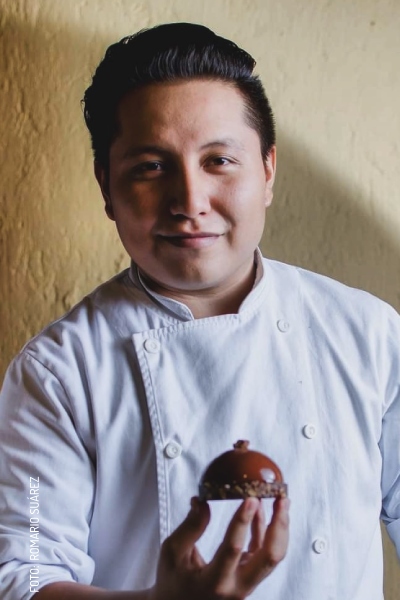
Mérida-born Romario Suárez was all set to become a doctor, and then love sort of got in the way. When he was a nursing student in high school, his girlfriend (now wife) Diana Lizeth signed up for a baking workshop; thinking he’d get some treats out of spending time with her, he offered to join her. Romario, he says, was fascinated from the beginning; he learned to make chocolate figurines, beat egg whites into meringue, and learned to make some traditional desserts such as flan and Volteado de Piña (pineapple upside-down cake). Then, chef Wilson Alonzo visited his school representing the Universidad Tecnológica del Poniente (Maxcanú) school of culinary arts; Romario enrolled using the money his mom had given him to enroll into medical school.
At school, his professors, including Obed Reyes and José Rodríguez, in addition to the aforementioned Wilson Alonzo, encouraged his passion for pastry arts and invited him to several events where he worked hard and perfected his techniques. Then, he interned in Cancun under chef Luis Ángel Parra, who was preparing to participate in the Coupe du Monde de la Pâtisserie (Pastry Arts World Cup), and which led to him learning from renowned chefs such as Pascal Demory and Fidel Baeza.
-1.jpg)
While he was working at the Playa del Carmen Hilton, heading the Panama Jack hotel kitchen, the pandemic hit, and he decided to come back to Mérida. Here, he reconnected with chef Christian Bravo, which took him to Crabster in Paseo 60. Not very long after, Romario was named corporate pastry chef for seven restaurants: Henequenes, Silver Fish, Matilda, Sanbravo, Mobula, and both Crabster restaurants (in Progreso and Paseo 60). If you’ve been to any of these restaurants, you’ll know that it’s very important to leave room for dessert there, as they all have outstanding options. Romario Suárez has had a hand in each of them. When asked about what his own favorite is, he doesn’t hesitate: a Queso de Bola (Edam cheese) dessert which he conceived as he was sharing a Marquesita with his son.
You can try the Queso de Bola at Crabster, or go to any of the restaurants mentioned above (Matilda, Sanbravo, Mobula, and both Crabster restaurants are advertisers in Yucatán Today) and try any of Romario’s decadent creations; they’re great for sharing, though you might regret not getting one for yourself.
Oh, and in case you’re wondering, Romario’s mom forgave him eventually.
Grupo JIGSA
Calle 50 #431, x 45 y 47, Centro, Mérida.
IG: romario7225
FB: Romario Luciano Suarez Fernández
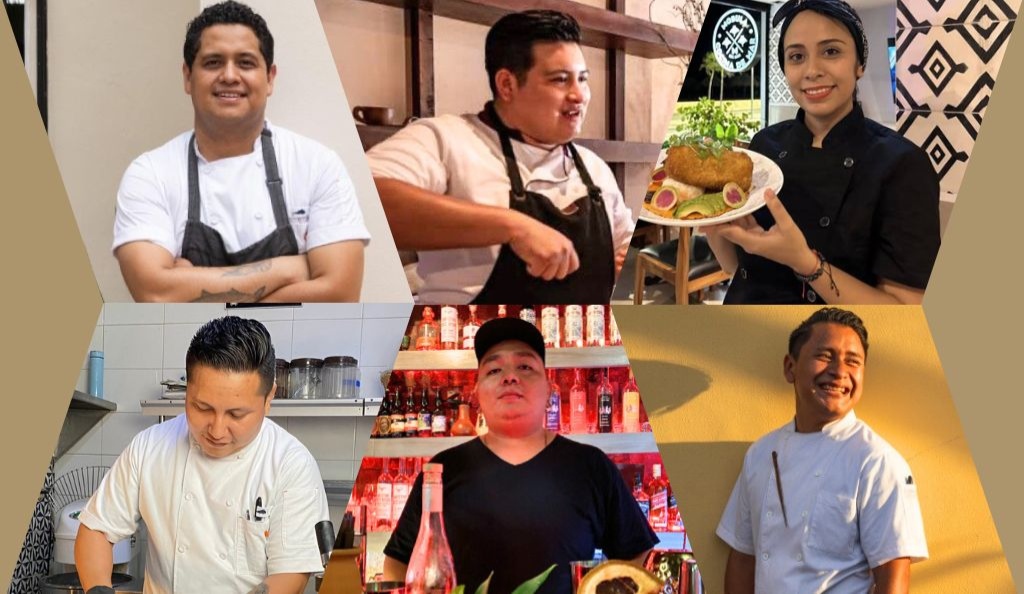
Photography by Erick Bautista, Renée Morales, Alicia Navarrete, Sharon Cetina, Jorge Manzanilla, and Pablo Luque for use in Yucatán Today.

Author: Alicia Navarrete Alonso
As a kid I heard that there's more to see than can ever be seen and more to do than can ever be done, so I set out to try. I'm passionate about knowledge and I love to share whatever my own is.
Receive the latest articles and much more from the best of Yucatán in your email!
Related articles
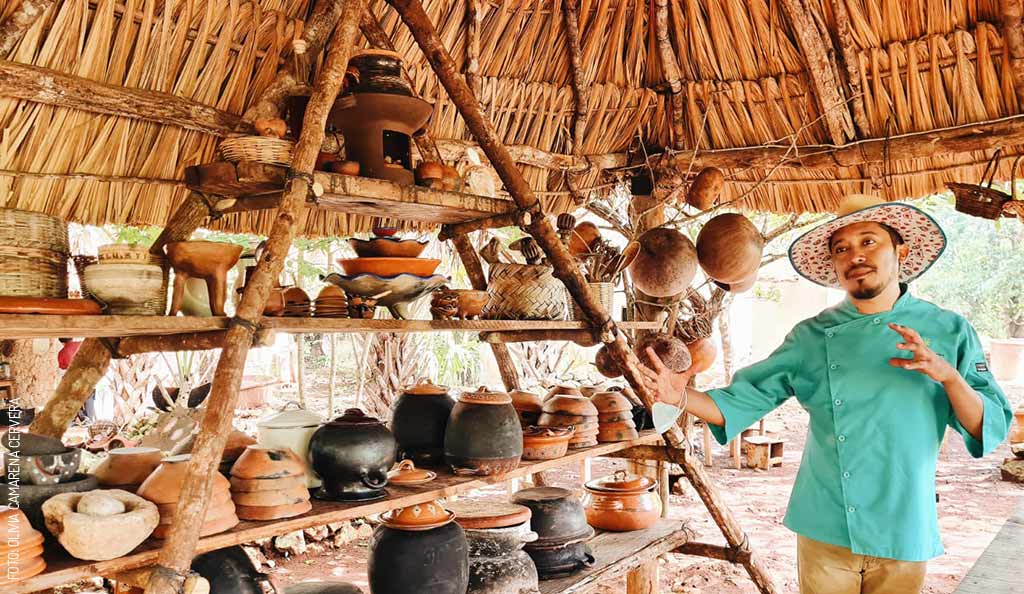
Culinary Experiences: Three Traditional Kitchens
If learning how the exquisite and authentic Yucatecan flavors are created sounds appetizing to you, stick around for 3 Traditional Kitchens.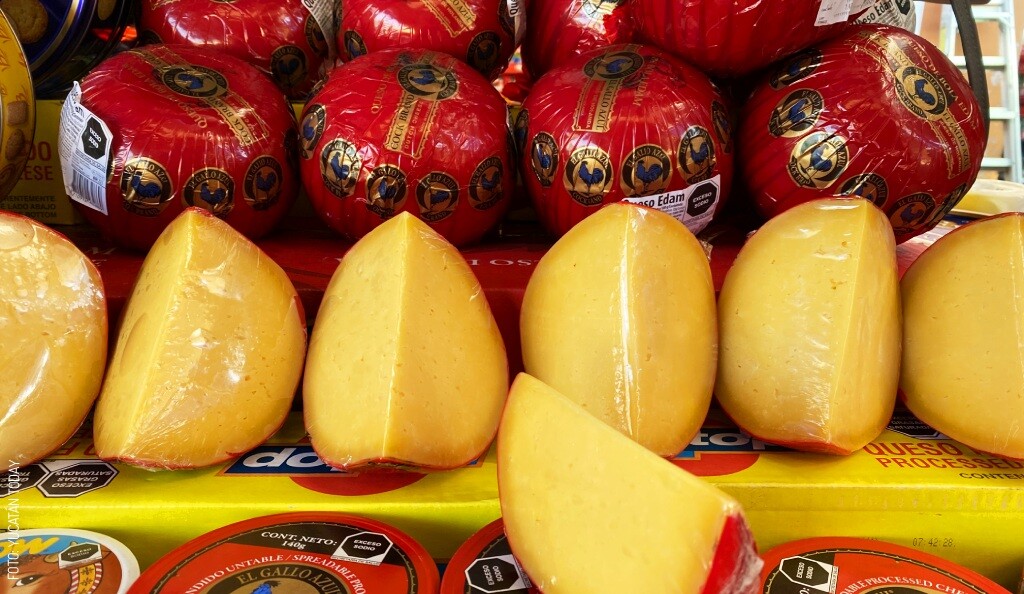
Queso de Bola, a Matter of Love
Today in Yucatán you can try a marquesita with queso de bola and Nutella, dulce de cajeta, and strawberries in any park.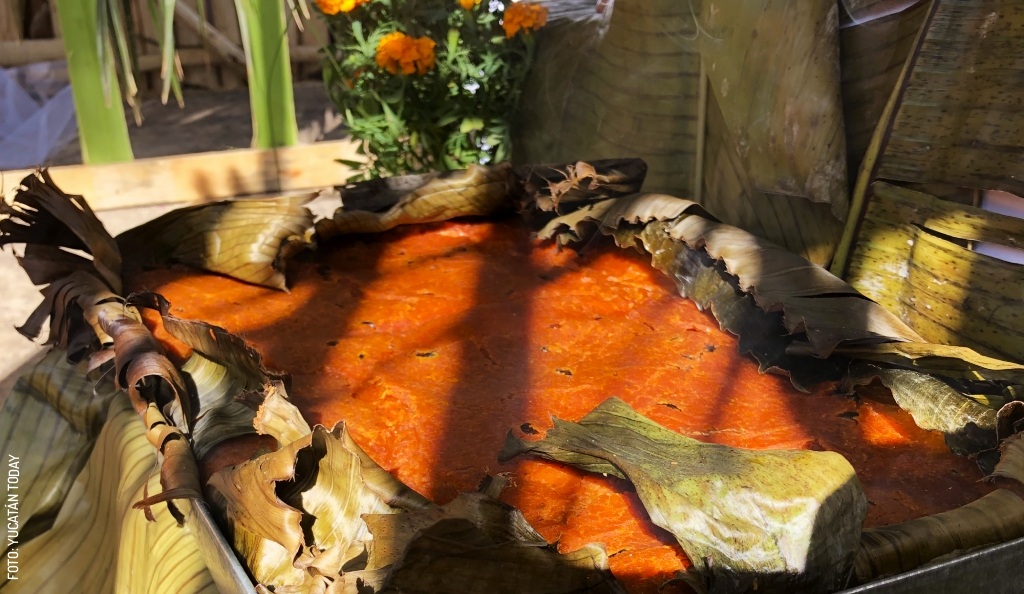




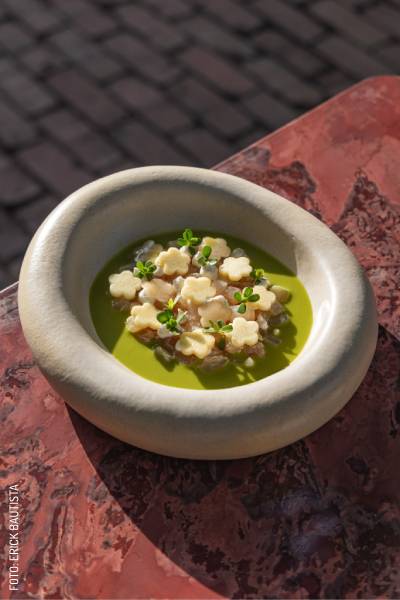
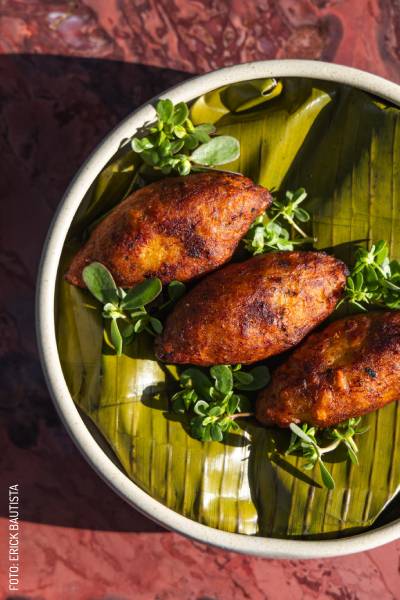
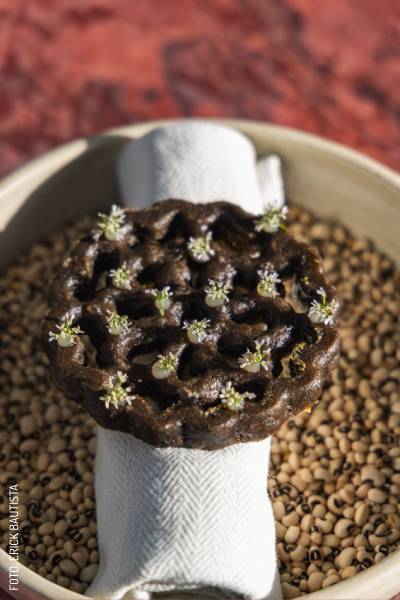
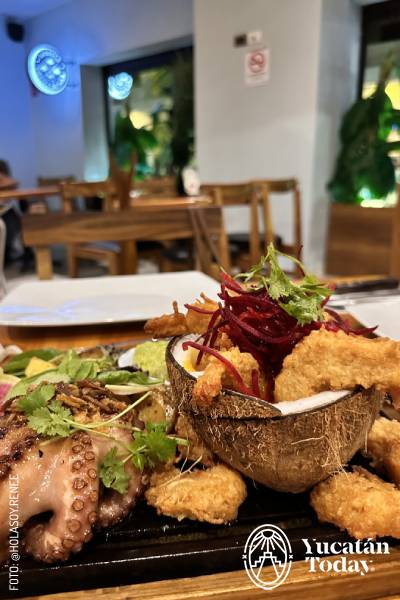
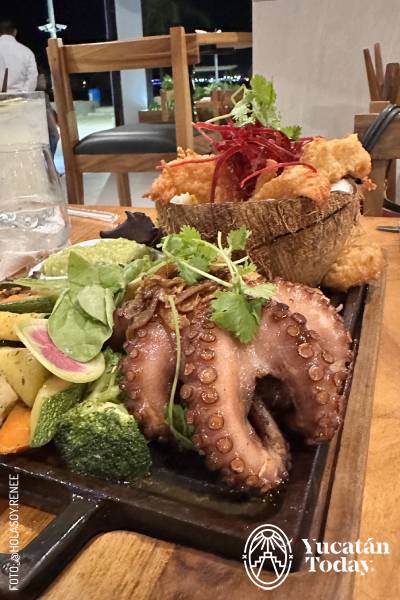
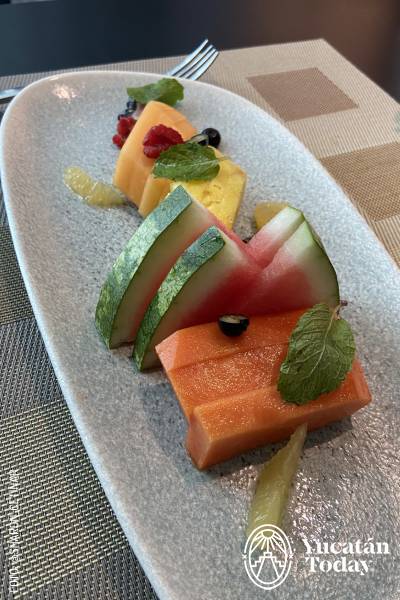
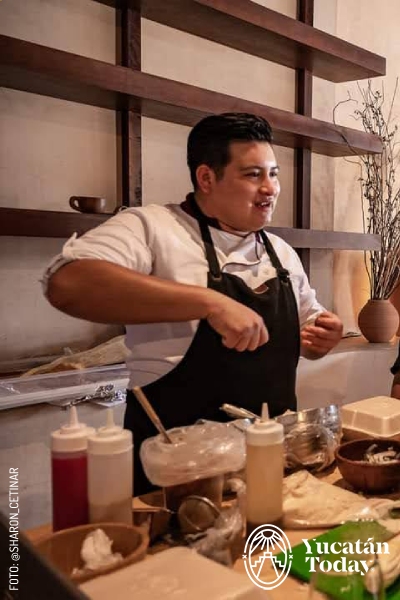
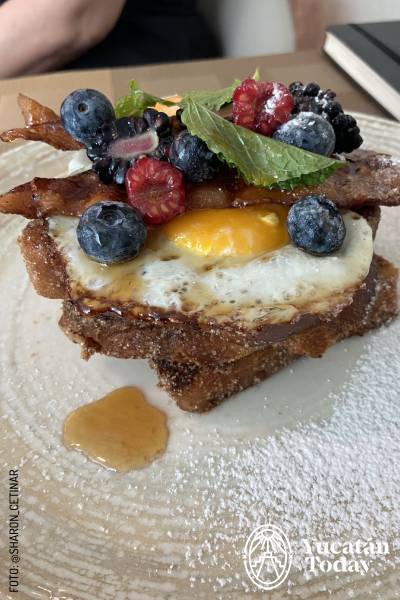
.jpg)
